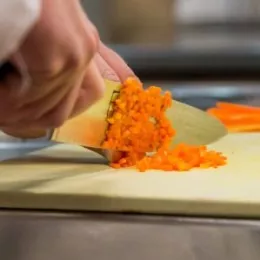Thai Cuisine, well known for its spiciness, is really better characterized by its complex balancing of five distinct flavors—sour, sweet, salty, bitter, spicy—and is the secret to mastering Thai food. Thai cuisine is vast and varied, heavily influenced by regional ingredients, food traditions and the cultures of surrounding countries. For instance, the food of Southern Thailand tends to be very spicy and incorporates a lot of seafood. In other regions, dishes are served with different types of rice—Central Thailand leans toward jasmine rice while sticky rice is a staple of Northeastern Thailand.
 During the last week of March, ICC and the National Research Council of Thailand hosted a 3-day series of hands-on classes, workshops and demonstrations promoting authentic Thai cuisine. Throughout the week, the techniques behind Thai cooking were shared to the ICC Community—including chef-instructors, current students and alumni—through the Thai Cuisine to Global Market project. Alumna of ICC’s Professional Culinary Arts program, Chanchana Siripanwattana, who brought the project back to her alma matter, was excited to help promote her country’s amazing food in NYC. From ingredients, techniques, unique recipes and cooking processes, read about what we learned in our week of activities below.
During the last week of March, ICC and the National Research Council of Thailand hosted a 3-day series of hands-on classes, workshops and demonstrations promoting authentic Thai cuisine. Throughout the week, the techniques behind Thai cooking were shared to the ICC Community—including chef-instructors, current students and alumni—through the Thai Cuisine to Global Market project. Alumna of ICC’s Professional Culinary Arts program, Chanchana Siripanwattana, who brought the project back to her alma matter, was excited to help promote her country’s amazing food in NYC. From ingredients, techniques, unique recipes and cooking processes, read about what we learned in our week of activities below.
THE HARMONY OF FLAVORS IS IMPORTANT
 Thai cuisine is all about balancing the five distinct flavors consistently found among the various dishes—sour, sweet, salty, bitter and spicy! Typically, a truly authentic dish has at least two of these flavors working together to pack a powerful punch. Many people initially think of Thai food as extremely spicy, but it’s important to know that not all Thai food is created equal.
Thai cuisine is all about balancing the five distinct flavors consistently found among the various dishes—sour, sweet, salty, bitter and spicy! Typically, a truly authentic dish has at least two of these flavors working together to pack a powerful punch. Many people initially think of Thai food as extremely spicy, but it’s important to know that not all Thai food is created equal.
COOKING TECHNIQUES IN THAILAND WERE LEARNED FROM MANY COUNTRIES
Thai cuisine is a melting pot of other culture’s techniques and flavors that, over thousands of years, were adapted to create the country’s distinct food culture. Popular stir-fry dishes came from China, while notable Thai curries were adapted from India’s well known versions. Different areas of Thailand also have vastly different cuisines because of ingredients readily available. The culture of regional villages and cities also vary depending on the influences of neighboring countries. So, if you’re travelling around Thailand, expect to experience new dishes in each place.
IT'S COMMON FOR FOOD TO BE SERVED AT ROOM TEMPERATURE
 Unlike Western cuisine where food is served chilled or piping hot, many Thai dishes are served at room temperature! Some say it’s to create a more relaxing dining experience, while others say its to help bring down the spice level in some dishes. Whatever the reason, don’t be surprised if a dish arrives at room temperature—it’s definitely intentional.
Unlike Western cuisine where food is served chilled or piping hot, many Thai dishes are served at room temperature! Some say it’s to create a more relaxing dining experience, while others say its to help bring down the spice level in some dishes. Whatever the reason, don’t be surprised if a dish arrives at room temperature—it’s definitely intentional.
The next time you order Thai food, or maybe even journey to Thailand, think about the balancing act of flavors that the chefs aim to achieve, the melting pot of techniques & cultures, as well as the differences in Western cuisine!
ABOUT CHANCHANA SIRIPANWATTANA
 Chanchana Siripanwattana is a 2011 graduate of ICC’s Professional Culinary Arts program. Before graduating with her Grande Diplomé, she received a Bachelors of Science in Microbiology from King Mongkut Institute of Technology and Masters of Food Technology from Chulalongkorn University. After spending time in NYC at ICC, Chanchana returned to Thailand to receive her PH. D. in Technopreneurship and Innovation Management from Chulalongkorn University. Now, she is the Head of Culinary Technology and Service at Suan Dusit University and also manages the university’s bakery by developing new products and using local ingredients. She is currently traveling with the Thai Cuisine to Global Market Project to bring the flavors of her home country around the world!
Chanchana Siripanwattana is a 2011 graduate of ICC’s Professional Culinary Arts program. Before graduating with her Grande Diplomé, she received a Bachelors of Science in Microbiology from King Mongkut Institute of Technology and Masters of Food Technology from Chulalongkorn University. After spending time in NYC at ICC, Chanchana returned to Thailand to receive her PH. D. in Technopreneurship and Innovation Management from Chulalongkorn University. Now, she is the Head of Culinary Technology and Service at Suan Dusit University and also manages the university’s bakery by developing new products and using local ingredients. She is currently traveling with the Thai Cuisine to Global Market Project to bring the flavors of her home country around the world!
This blog post was originally published by the International Culinary Center (ICC), founded as The French Culinary Institute (FCI). In 2020, ICE and ICC came together on one strong and dynamic national platform at ICE's campuses in New York City and Los Angeles. Explore your culinary education where the legacy lives on.



